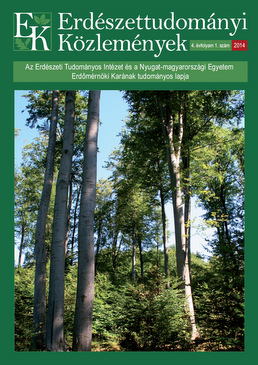| 1. | Ádám R. és Bölöni J. 2011: Cseres-kocsánytalan tölgyesek gyepszintjének kapcsolata az állomány jellemzőivel. 34-37. In: Mázsa K. (ed.): Válogatás az MTA Ökológiai és Botanikai Kutatóintézet Kutatási eredményeiből, 2011. ÖBKI, Vácrátót, 34-37. |
| 2. | Anon. 2012: Erdővagyon, Erdő- és Fagazdálkodás Magyarországon 2012. Nébih Erdészeti Igazgatóság, Budapest. |
| 3. | Arend, M.; Brem, A.; Kuster, T.M. and Günthardt-Goerg, M.S. 2013: Seasonal photosynthetic responses of European oaks to drought and elevated daytime temperature. Plant Biology, 15: 169-176. DOI: 10.1111/j.1438-8677.2012.00625.x |
| 4. | Balandier, P.; Marquier, A.; Casella, E.; Kiewitt, A.; Coll, L.; Wehrlen, L. and Harmer, R. 2012: Architecture, cover and light interception by bramble (Rubus fruticosus): a common understorey weed in temperate forests. Forestry, 86: 39-46. DOI: 10.1093/forestry/cps066 |
| 5. | Bartha D. és Puskás L. 2013: Silva naturalis Vol.1. Nyugat-magyarországi Egyetem Kiadó, Sopron. |
| 6. | Bengtsson, J.; Nilsson, S.G.; Franc, A. and Menozzi, P. 2000: Biodiversity, disturbances, ecosystem function and management of European forests. Forest Ecology and Management, 132: 39-50. DOI: 10.1016/s0378-1127(00)00378-9 |
| 7. | Bölöni J.; Fekete G.; Kun A.; Tímár G.; Bartha D.; Szmorad F.; Nagy, J. és Juhász M. 2011: L2a – Cseres kocsánytalan tölgyesek. 308-314. In: Bölöni J.; Molnár Zs. és Kun A. (szerk.): Magyarország élőhelyei. Vegetációtípusok leírása és határozója. MTA ÖBKI, Vácrátót. |
| 8. | Březina, I. and Dobrovolný, L. 2011: Natural regeneration of sessile oak under different light conditions. Journal of Forest Science, 57: 359-368. |
| 9. | Collins, B.S., Dunne, K.P. and Pickett, S.T.A. 1985: Responses of forest herbs to canopy gaps. 218-234. In: Pickett, S.T.A. and White, P.S. (eds): The Ecology of Natural Disturbance and Patch Dynamics. Academic Press, Orlando, Florida. DOI: 10.1016/b978-0-12-554520-4.50017-4 |
| 10. | Csontos P. 1996: Az aljnövényzet változásai cseres-tölgyes erdők regenerációs szukcessziójában. Scientia Kiadó, Budapest, 122 pp. |
| 11. | Csontos, P. 2010: Light ecology and regeneration on clearings of sessile oak - Turkey oak forests in the Visegrád Mountains, Hungary. Acta Botanica Hungarica, 52 (3-4): 265–286. DOI: 10.1556/abot.52.2010.3-4.6 |
| 12. | Ellenberg, H. und Leuschner, C. 2010: Vegetation Mitteleuropas mit den Alpen, 6th ed. Ulmer Verlag, Stuttgart. |
| 13. | Gálhidy L. 2008: Az aljnövényzet fajösszetételének és tömegességének változásai középhegységi bükkösök mesterséges és széldöntés nyomán létrejövő lékjeiben. Doktori értekezés. ELTE, Növényrendszertani és Ökológiai Tanszék, Budapest. |
| 14. | Gencsi L. és Vancsura R. 1992: Dendrológia. Mezőgazda kiadó, Budapest. |
| 15. | Hegi, G. 1995: Illustrierte Flora von Mitteleuropa. Band IV, Teil 2A, Blackwell Wissenschaft Verlag. |
| 16. | Kalapos, T. and Csontos, P. 2003: Variation in leaf structure and function of the Mediterranean tree Fraxinus ornus L. growing in ecologically contrasting habitats at the margin of its range. Plant Biosystems, 137: 73-82. DOI: 10.1080/11263500312331351351 |
| 17. | Kenderes K., Tímár G., Ódor P., Bartha D., Standovár T., Bodonczi L., Bölöni J., Szmorad F. és Aszalós R. 2007: A természetvédelem hatása középhegységi erdeinkre. Természetvédelmi Közlemények, 13: 69-80. |
| 18. | Koncz G. 2013: Cseres-tölgyes erdők (Síkfőkút project és Vár-hegy) lágyszárú növényzet és magkészlet vizsgálata. Egyetemi doktori (PhD) értekezés, Debreceni Egyetem. |
| 19. | Le Duc, M.G. and Havill, D.C. 1998: Competition between Quercus petraea and Carpinus betulus in an ancient wood in England: seedling survivorship. Journal of Vegetation Science, 9: 873-880. DOI: 10.2307/3237052 |
| 20. | Legner, N.; Fleck, S. and Leuschner, C. 2014: Within-canopy variation in photosynthetic capacity, SLA and foliar N in temperate broad-leaved trees with contrasting shade tolerance. Trees, 28: 263-280. DOI: 10.1007/s00468-013-0947-0 |
| 21. | Lüpke, B. 1998. Silvicultural methods of oak regeneration with special respect to shade tolerant mixed species. Forest Ecology and Management, 106: 19-26. DOI: 10.1016/s0378-1127(97)00235-1 |
| 22. | McCarthy, J. 2001: Gap dynamics of forest trees: A review with particular attention to boreal forests. Environmental Reviews, 9: 1-59. DOI: 10.1139/er-9-1-1 |
| 23. | McDowell, S.C.L. 2002: Photosynthetic characteristics of invasive and non-invasive species of Rubus (Rosaceae). American Journal of Botany, 89: 1431-1438. DOI: 10.3732/ajb.89.9.1431 |
| 24. | Mihók B. 2007: Lékek fénymintázata és növényzeti regenerációja bükkös állományokban. Doktori értekezés. ELTE TTK, Növényrendszertani és Ökológiai Tanszék, Biológia Doktori Iskola, Budapest. |
| 25. | Mózes Cs. (szerk.) 2004: Erdővagyon, erdő- és fagazdálkodás Magyarországon. FVM Erdészeti Hivatal Kiadványa, Budapest. |
| 26. | Phillips, D.L. and Shure, D.J. 1990: Patch-Size Effects on Early Succession in Southern Appalachian Forests. Ecology, 71: 204-212. DOI: 10.2307/1940260 |
| 27. | Rigling, A.; Bigler, C.; Eilmann, B.; Feldmeyer-Christe, E.; Gimmi, U.; Ginzler, C.; Graf, U.; Mayer, P.; Vacchiano, G.; Weber, P.; Wohlgemuth, T.; Zweifel, R. and Dobbertin, M. 2013: Driving factors of a vegetation shift from Scots pine to pubescent oak in dry Alpine forests. Global Change Biology, 19: 229-240. DOI: 10.1111/gcb.12038 |
| 28. | Ritter, E. and Vesterdal, L. 2006: Gap formation in Danish beech (Fagus sylvatica) forests of low management intensity: soil moisture and nitrate in soil solution. European Journal of Forest Research, 125: 139-150. DOI: 10.1007/s10342-005-0077-3 |
| 29. | Siffer S. 2012: Szálalás száraz tölgyesekben. 121–133. In: Gyöngyössy P. (szerk.): Múlt és jövő IV. Tartamosság, természetszerűség, társadalmi kontroll. Nyugat-magyarországi Egyetem, Sopron. |
| 30. | Solymos R. 2011: Természetes erdőfelújítás – folyamatos erdőborítás. Erdészeti Lapok, 151: 72-74. full text |
| 31. | Standovár T. 2006: Biológiai megfontolások az erdei életközösségek hatékony védelméhez. Magyar Tudomány, 2006/6: 656-662. |
| 32. | Struve, D.K., Ferrini, F.; Fini, A. and Pennati, L. 2009: Relative growth and water use of seedlings from three Italian Quercus species. Arboriculture and Urban Forestry, 35: 113-121. |
| 33. | Tognetti, R.; Cherubini, P.; Marchi, S. and Raschi, A. 2007: Leaf traits and tree rings suggest different water-use and carbon assimilation strategies by two co-occurring Quercus species in a Mediterranean mixed-forest stand in Tuscany, Italy. Tree Physiology, 27: 1741-1751. DOI: 10.1093/treephys/27.12.1741 |
| 34. | Yamamoto, S.-I. 2000: Forest Gap Dynamics and Tree Regeneration. Journal of Forest Research, 5: 223-229. DOI: 10.1007/bf02767114 |
